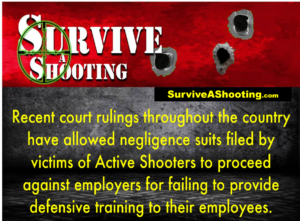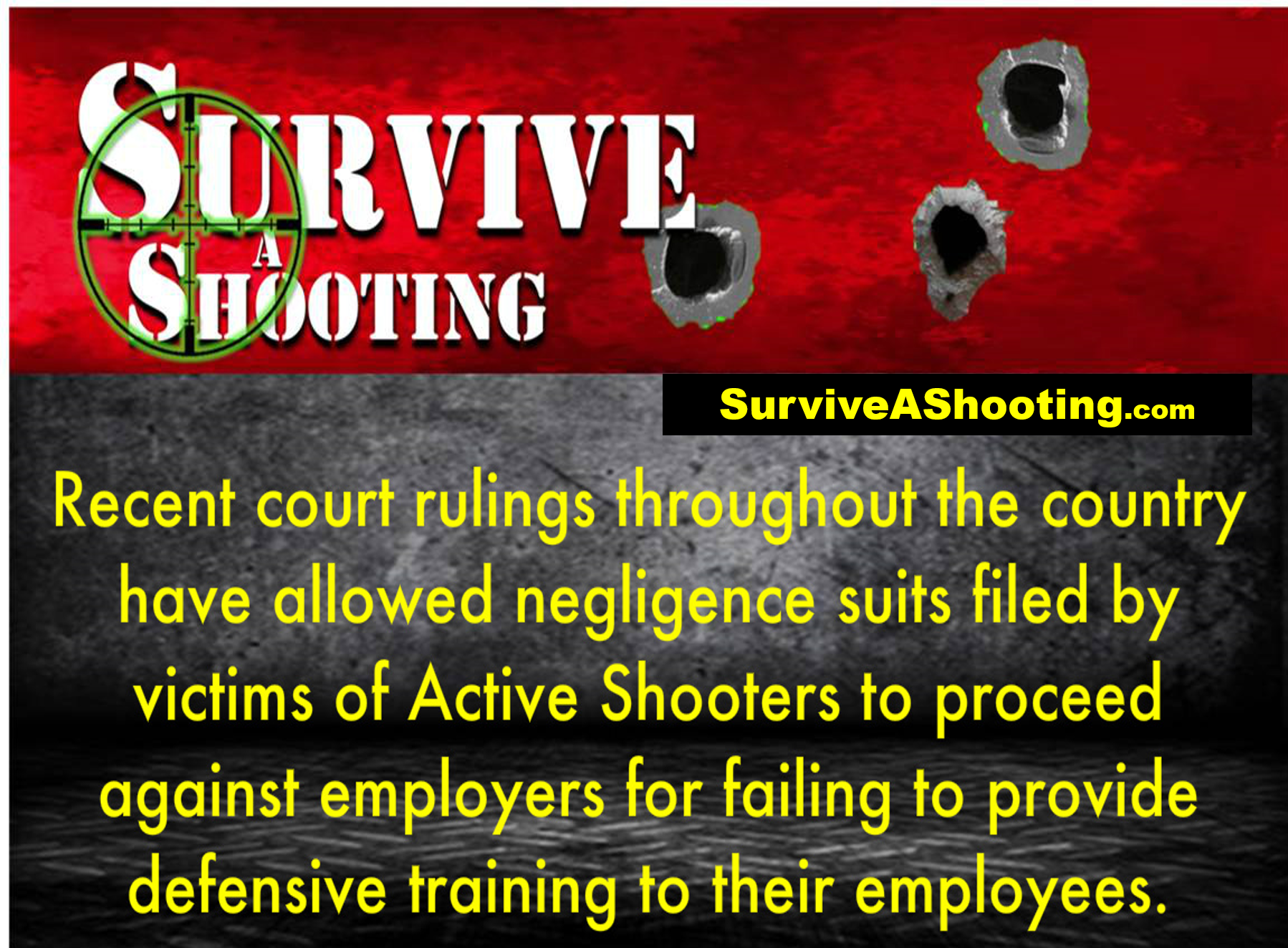 Recent active shooter court rulings throughout the country have allowed negligence suits filed by victims of Active Shooters to proceed against employers for failing to provide defensive training to their employees. In other words, companies can no longer avoid their corporate responsibility to provide training on both how to spot potential active shooters and on how react if so confronted.
Recent active shooter court rulings throughout the country have allowed negligence suits filed by victims of Active Shooters to proceed against employers for failing to provide defensive training to their employees. In other words, companies can no longer avoid their corporate responsibility to provide training on both how to spot potential active shooters and on how react if so confronted.
One of the allegations in the lawsuit against the town of Newtown and the Newtown Board of Education was lack of training. The lawsuit also alleges the town and school board were negligent in not having a more secure entrance to the school because it did not have bulletproof glass on the front windows and for having classroom doors that couldn’t be locked from the inside. (All things covered in the Survive a Shooting course.)
The 66-page lawsuit filed after the terrible Sandy Hook shooting lists a variety of reasons why the plaintiffs consider the school system to have been negligent, resulting in the many deaths there.
According to the lawsuit, school officials failed to provide the school with classroom doors that could be locked from the inside, thereby making the “lockdown” aspect of that school’s safety procedures virtually impossible to follow.
The lawsuit also alleges that school officials failed to sufficiently train and supervise the staff on the proper way to implement lockdown and evacuation plans. Classrooms in the school could only be locked from the outside with a key, in violation of state law, it alleges.
https://newtownbee.com/settlement-offers-made-in-sandy-hook-school-lawsuit/
According to an article by James Cameron, CPP, recent active shooter court rulings relative to liability lawsuits have shown active shooter scenarios are now considered a “recognizable hazard” to employees.
One of the regulations under the Occupational Safety & Health Administration Section OSHA of the United States Department of Labor *General Duty Clause, Section 5 (a)(1) states, “Each employer shall furnish to each of his/her employees, employment and a place of employment which are free from recognized hazards that are causing or are likely to cause death or serious physical harm to his/her employees”.
Example from Cameron of recent active shooter court rulings:
In a July 2, 2013 court decision from Hennepin County, Minneapolis, MN, the court found fault with the employer for negligence and failing to train their employees. District Court Judge Denise Reilly allowed two negligence counts to proceed against the company, Accent Signage. The civil case was brought before the courts by the victims’ family members in response to an active shooter incident at a place of business.
This incident occurred as the gunman, Andrew Engeldinger, walked into his place of employment on September 27, 2012 with a pistol. Once inside, Engeldinger shot and killed numerous individuals before taking his own life. Court rulings like the one above places the liability on the employer to train their employees to recognize the indicators of the potential active shooter and how to respond when they are faced with an actual active shooter incident.
The charges basically follow the OSHA guidelines set forth under the “General Duty Clause” that the employer needed to make training available and reasonable safeguards to be put in place. One of the victims, Beneke’s family sued the Accent Signage and Engeldinger’s estate in February. Releasing the shooters estate from liability and holding the company responsible is a new shift in thoughts regarding pre-planning and prevention. Engeldinger shot and killed Beneke, and four other employees and co-workers along with a UPS deliveryman before committing suicide on September 27, 2012.
This case has now settled for an undisclosed amount of money by Accent Signage to the Beneke family.
Train Employees
Based on these recent active shooter court rulings, and OSHA recommendations, employers should implement training and notification programs/systems to educate employees on the known risks for workplace violence and the steps that can be taken by employees to minimize the potential for workplace violence. This includes being trained on how to effectively respond to workplace emergencies to include active shooter situations.
Read this review of the Survive A Shooting course.

